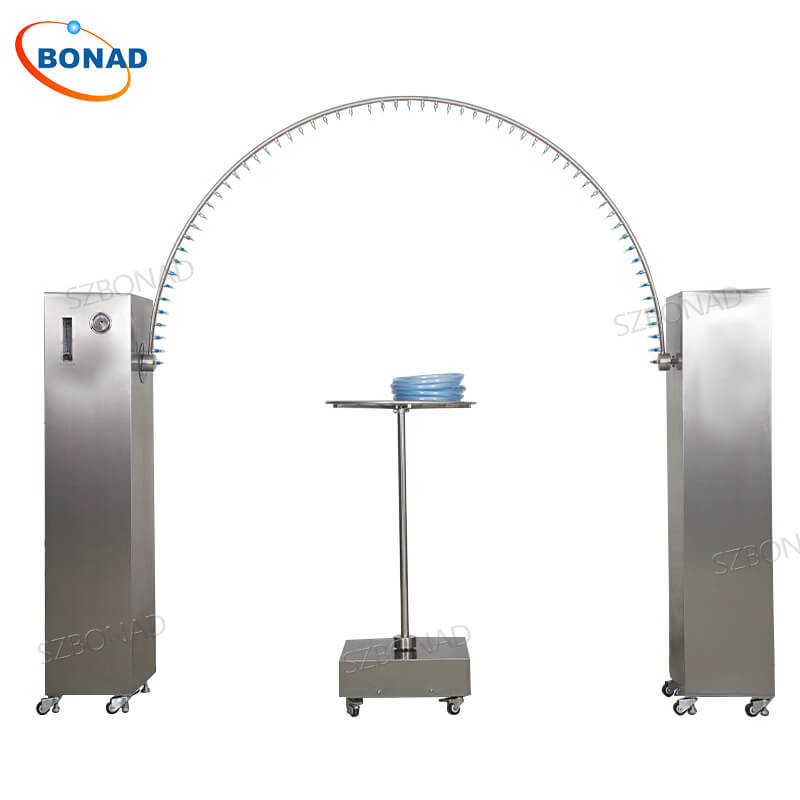IPX3 ingress protection testing is a crucial process designed to assess the water resistance of electronic devices and enclosures. This test simulates exposure to water sprays from various directions, mimicking conditions like rainfall or splashing. The primary goal of IPX3 testing is to determine a device’s ability to withstand water exposure without compromising its functionality.
What Does the IPX3 Rating Mean?
The IPX3 rating comes from the IEC 60529 standard. The “IP” stands for Ingress Protection, followed by two digits that indicate the level of protection. The first digit refers to protection against solid particles, while the second digit (in this case, “3”) signifies protection against water.
How is IPX3 Testing Conducted?
IPX3 testing can be performed using either an oscillating tube or a spray nozzle:
- Oscillating Tube Method: Water flows at approximately 0.07 liters per minute per hole, multiplied by the number of holes. The flow rate is controlled via a flow meter. The tube oscillates through an arc of 60 degrees on either side of the center point, covering an angle range from 120 degrees to 60 degrees on either side of vertical. Each complete oscillation takes about four seconds, with a total test duration of five minutes per position. Afterward, the enclosure is rotated 90 degrees horizontally and tested for another five minutes.
- Spray Nozzle Method: Water flows at around 10 liters per minute with pressure ranging between 50 kPa and 150 kPa. This pressure remains constant throughout the test. The duration is one minute per square meter of the enclosure, with a minimum test time of five minutes.
Post-testing, the device is inspected for any signs of water ingress such as discoloration, deformation, or other physical changes. The acceptance criteria state that water sprayed at up to 60 degrees on either side of vertical should not cause harmful effects.
Why Conduct IPX3 Ingress Protection Testing?
The main purpose of IPX3 testing is to ensure that electronic devices and enclosures are safeguarded against water damage, thereby preventing potential electrical failures and malfunctions due to water exposure.
Benefits for Manufacturers
For manufacturers, IPX3 testing helps identify design flaws that might allow water penetration. It ensures that devices can perform optimally in various environments, providing valuable feedback for product improvement.
Benefits for Consumers
Consumers benefit from knowing that an IPX3-certified product offers a certain level of water resistance. This assurance allows them to use their devices in different environments without worrying about water damage.
Common Causes of Failure in IPX3 Testing
Failures in IPX3 testing often result from poor design, subpar manufacturing processes, or inappropriate material selection. Common issues include failing seals or gaps in the enclosure, often due to materials that rust or corrode when exposed to water.
Types of Equipment Tested for IPX3 Certification
IPX3 certification is particularly important for outdoor products exposed to inevitable water contact. This includes outdoor appliances like speakers and garden lights, household appliances such as refrigerators and washing machines, portable electronics like smartphones and tablets (although higher levels of protection are often required), medical devices including defibrillators and infusion pumps, and industrial tools used both indoors and outdoors.
It’s crucial to note that while an IPX3 rating indicates water resistance, it does not mean the device is waterproof.
BONAD High Quality Ipx3 Waterproof Testing Equipment
We specialize in the high quality of: electronic safety tester, accessibility test probe and test finger, laboratory test equipment and test Chamber, waterproof test equipment, environmental test Equipment, freezing test package, all kinds of gauge and sensor and so on.
IPX3/4 Oscillating Tube Comprehensive Rain Test Equipment



